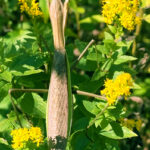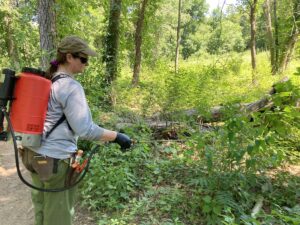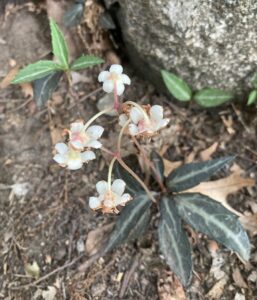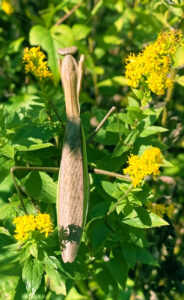
By Jeffrey North
In 2020, the Land Management Committee for Lone Tree Hill (LMC) and the Judy Record Conservation Fund began a multi-year campaign to restore native plant communities in prioritized areas of the Lone Tree Hill conservation land. Step one in the restoration was to bring the invasive plant species under control. Planting natives would be a wasted effort and expense if they cannot compete with the pernicious plants that have come to occupy large swaths of our conservation lands and private yards.
The work began with a broad brush, property-wide restoration survey conducted by ecological design professionals in the 2020 Invasive Plant Management and Native Plant Restoration Plan, which was generously underwritten by the Judy Record Conservation fund. The Belmont Citizens Forum Newsletter has reported on these invasive species control and ecological restoration initiatives since their inception.
Second restoration year actions
The scope of work for 2022 included herbicide and manual treatments to re-emerging invasive species including glossy and common buckthorn, garlic mustard, black swallow-wort, and Asiatic bittersweet. Herbicide application methods consisted of a cut-and-dab method for previously cut woody plants and a foliar spray for re-sprouting shoots on herbaceous and woody target plants. Mechanical removal methods were employed in areas where they were more effective and efficient.

Parterre employee applying herbicide to invasive plants on Lone Tree Hill. Photo: Parterre Ecological Services
None of these control measures will bring the invasives under permanent control in just one season. Some are more resilient than others, but they all have biological tricks that strengthen their capabilities for survival and spread.
Several patches of Japanese knotweed were added to the program in 2022, notably about 4,000 sq. ft. between the Meadow Edge Trail and Summit Road and another 1,000 sq. ft. of nasty knotweed near the Concord Avenue cell tower. This area will require repeated visits by the contractor over several years, as knotweed is notorious for its ability to come back seemingly from the dead after treatment.
In the Great Meadow, re-emergence of black swallow-wort, purple loosestrife, and porcelain berry was addressed with herbicide and hand pulling in early 2022 after two herbicide treatments in 2021.
In late 2021, to create a new pollinator meadow, the contractor mowed an area near the Mill Street parking lot and prepared the soil for planting a mix of wildflower seeds. In early 2022, ecological field technicians selectively sprayed targeted weeds with herbicide during active growth and likely weed invasion. Unfortunately, few wildflowers appeared, probably due to drought conditions and thin soil atop this disturbed patch of ground. Parterre declared the work unsuccessful, and in December, field technicians amended the soil with four cubic yards of a compost and loam mix. They seeded the area with a combination of local seeds collected at other sites and a commercial semi-shade forb mix. Parterre covered all of the extra work under warranty.
Volunteers attack buckthorn
In 2021 and 2022, volunteers cut buckthorn by hand in areas totaling 10 acres. The contractor followed the volunteers’ work with herbicide treatment of resprouting buckthorn in a one-two punch to this pervasive invasive. Controlling the buckthorn in edges and forested areas enhances the property’s aesthetic value, opening new vistas and clearing space for dogwood, pine, hickory, and oak trees to return to their ancestral land.
The Invasives Working Group
A new working group was appointed and charged by the LMC to plan invasive species treatment and oversee contractors. The immediate goal of the Invasives Working Group is to advise the LMC in developing a program for sustainable long-term land management practices, initially through 2030. The group is dedicated to Lone Tree Hill, although in the future it may assist the town with activities conducted by vendors, town employees, and volunteers to control the proliferation of invasive plant species. The current Invasives Working Group members are Joe Hibbard, Leonard Katz, and Jeffrey North. To learn about volunteer opportunities, please contact Leonard at ldkatz86@gmail.com.
2022 observations
More native plants were observed in Lone Tree Hill this season compared to years past, including various goldenrod species, chokecherry, Virginia creeper, false Solomon’s seal, Eastern woodland sedge, Ribes (currants), wild sarsaparilla, Jack in the pulpit, Solomon’s seal, and staghorn sumac. It is exciting to see many natives returning and becoming established. For example, canadensis, altissima, and rugosa goldenrod species are quickly establishing themselves in the open meadow and will continue to spread by rhizome and seed.
Invasive plants still on site include black swallow-wort, common and glossy buckthorn, porcelain berry, bittersweet, yellow rocket, dames rocket, bittersweet nightshade, multiflora rose, bind weed, honeysuckle, Norway maple, and ailanthus. Black swallow-wort, garlic mustard, and knotweed are still present but in much lower quantities compared to last season. The areas of dense invasion will require more time to restore, but the stewards of Lone Tree Hill will prevail.

Native Chimaphila maculata (spotted wintergreen) at Lone Tree Hill. Photo: Parterre Ecological Services
Future steps
The Invasives Working Group will meet with the LMC in January to review the progress made in 2022 and plan the next season’s initiatives. The Invasives Working Group eagerly anticipates the planting of native species in specially selected areas to establish mother colonies of chosen plant species such as Pycnanthemum muticum (mountain mint), Monarda fistulosa (bee balm), Heliopsis helianthoides (false sunflower), Rudbeckia laciniata (cutleaf coneflower), Vernonia glauca (tawny ironweed), Symphyotrichum novae-angliae (New England aster), Solidago speciosa (showy goldenrod), Sorghastrum nutans (Indiangrass), Panicum virgatum (switchgrass).
Thank You
The LMC and visitors to the conservation land are once again grateful for the continued financial support and sage guidance from the board members of the Judy Record Conservation Fund: Roger Wrubel, executive director; Eugene Record, treasurer; and David O’Neill, president of Mass Audubon.
Jeffrey North is the managing editor of the Belmont Citizens Forum Newsletter and the 2022 chair of the Invasive Working Group, a subcommittee of the Land Management Committee for Lone Tree Hill.



Sorry, the comment form is closed at this time.